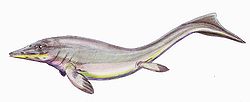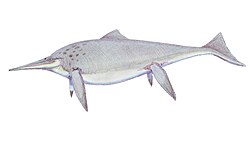| Argovisaurus Temporal range: Middle Jurassic | |
|---|---|
 | |
| Holotype block | |
| Scientific classification | |
| Kingdom: | Animalia |
| Phylum: | Chordata |
| Class: | Reptilia |
| Superorder: | † Ichthyopterygia |
| Order: | † Ichthyosauria |
| Node: | † Ophthalmosauria |
| Genus: | † Argovisaurus |
| Species: | †A. martafernandezi |
| Binomial name | |
| †Argovisaurus martafernandezi Miedema et al., 2024 | |
Argovisaurus (meaning "Aargau lizard") is an extinct genus of ophthalmosaurian ichthyosaurs from the Middle Jurassic (Bajocian) Hauptrogenstein Formation of Switzerland. The genus contains a single species, A. martafernandezi, known from a partial skeleton. Argovisaurus was a large ichthyosaur compared to its relatives.









